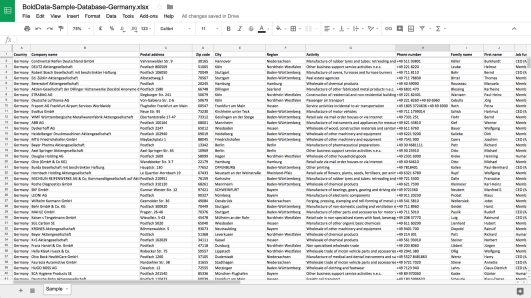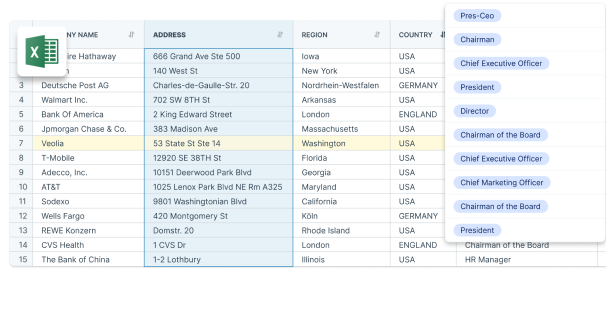Introduction
Customer service is the backbone of any successful call center. Efficient and effective customer interactions drive satisfaction, loyalty, and ultimately, business growth. Call center analytics plays a crucial role in this ecosystem. By collecting and analyzing data from various touchpoints, it offers actionable insights into performance metrics, customer behavior, and operational efficiency. These insights help managers make data-driven decisions to enhance both customer service and overall performance.
In addition to call center analytics, another valuable tool for optimizing customer service is data enrichment. By leveraging data enrichment services, call centers can enhance their customer database with high match rates, fill gaps in information, ensure accuracy, and gain valuable insights to inform their B2B strategies.
In this article, we will explore how call center analytics can be leveraged to enhance customer service and improve overall performance. We will also discuss the importance of data enrichment in achieving these goals.
Understanding Call Center Analytics
Definition and Purpose
Call center analytics involves collecting and analyzing data to monitor and improve call center performance. This data-driven approach helps identify trends, measure outcomes, and make informed decisions to enhance customer service.
Commonly Used Metrics and KPIs for Performance Evaluation
Key Performance Indicators (KPIs) are essential to assess the efficiency of call centers. Some crucial metrics include:
- Average Handle Time (AHT): Time taken to handle a call from start to finish.
- First Call Resolution (FCR): Percentage of calls resolved on the first attempt.
- Customer Satisfaction Score (CSAT): Measurement of customer satisfaction post-interaction.
- Service Level: Percentage of calls answered within a specified time frame.
These KPIs provide insights into agent performance, customer experience, and operational efficiency.
Tracking and Analyzing Call Volume to Ensure Efficient Operations
Understanding call volume patterns is critical for resource allocation. High call volumes may indicate peak periods requiring additional staffing, while low volumes could suggest overstaffing during certain times.
By tracking call volume, businesses can:
- Optimize workforce planning
- Adjust schedules based on demand
- Improve response times
For businesses looking to enhance their telemarketing efforts, BoldData offers targeted B2B call center data that can ensure efficient operations by providing accurate contact information tailored to your needs. Additionally, BoldData provides cold calling lists specifically designed to facilitate better planning and execution in call centers.
Effective analysis of these metrics leads to better decision-making, ultimately driving superior customer service.
Types of Call Center Analytics
Call center analytics encompasses several types of data analysis techniques each serving unique purposes:
1. Business Intelligence (BI)
Business Intelligence (BI) leverages data to provide actionable insights. By analyzing key performance indicators and trends, BI helps in making informed decisions, optimizing processes, and strategizing effectively.
2. Interaction Analytics
Interaction Analytics dives deep into customer interactions across various channels. It evaluates text-based communications such as emails and chat sessions to understand customer sentiment, preferences, and behaviors. This data can be used to tailor services and improve customer satisfaction.
3. Speech Analytics
Speech Analytics technology transcribes and analyzes voice calls, extracting valuable information from conversations. Patterns, emotions, and keywords are identified to gauge customer sentiment and identify areas for improvement. This empowers agents with insights to enhance their communication strategies.
4. Predictive Analytics
Predictive Analytics uses historical data to forecast future outcomes. In call centers, it predicts call volumes, customer needs, and potential issues. This proactive approach enables better resource allocation, ensuring the center runs efficiently during peak times.
Understanding these different types of analytics provides a comprehensive view of how data can be harnessed to elevate call center operations and enhance customer service quality.
Benefits and Applications of Call Center Analytics
1. Improving Workforce Planning Strategies through Data Analysis
Call center analytics enables precise workforce planning. By analyzing call patterns and peak hours, managers can schedule agents effectively, reducing idle time and ensuring sufficient coverage during busy periods.
2. Optimizing Resource Allocation for Enhanced Efficiency and Cost Savings
With detailed data insights, resource allocation becomes more efficient. Identifying underutilized resources and reallocating them where needed leads to cost savings and streamlined operations.
3. Enhancing Customer Engagement and Satisfaction with Analytical Insights
Analytics provides a window into customer behavior and preferences. Understanding these insights helps tailor interactions, personalizing service to boost engagement and satisfaction levels.
4. Driving Agent Performance and Development through Measurable Metrics
Measurable metrics such as Average Handle Time (AHT) and First Call Resolution (FCR) highlight performance areas needing improvement. Agents receive targeted training based on these metrics, fostering continuous development and excellence in service delivery.
Key Metrics for Measuring Call Center Success
Evaluating Average Handle Time (AHT) to Ensure Timely Resolutions and Productivity Average Handle Time (AHT) is critical in gauging the efficiency of call center agents. It encompasses the total duration from when a call is initiated to its conclusion, including any post-call work. Lower AHT indicates quicker problem resolution, enhancing customer satisfaction and increasing the number of calls handled.
How to Improve AHT:
- Provide comprehensive training for agents to boost their proficiency.
- Utilize call scripts to streamline conversations.
- Implement advanced CRM systems for faster data retrieval.
Measuring Service Level Adherence for Quality Assurance
Service level adherence measures the percentage of calls answered within a predetermined timeframe. High service level adherence ensures that customers are not left waiting, which directly impacts their overall experience.
Key Actions to Enhance Service Level:
- Monitor real-time call traffic and adjust staffing accordingly.
- Employ intelligent call routing to distribute calls efficiently.
- Regularly analyze service level data to identify and address bottlenecks.
Additional Key Metrics
- First-Call Resolution Rate: Measures the percentage of issues resolved within the first call. High rates signify effective problem-solving strategies and improved customer satisfaction.
- Customer Satisfaction Scores: Collected through post-call surveys, these scores provide direct feedback on the customer’s experience and help identify areas needing improvement.
By focusing on these key metrics, call centers can significantly enhance their operational efficiency and customer service quality.
Choosing the Right Call Center Analytics Solution for Your Business
Important Features to Consider
When choosing a call center analytics solution, it’s important to look for these key features:
- Real-Time Monitoring: See what’s happening in your call center right now.
- Customizable Dashboards: Create personalized views of your data.
- Integration Capabilities: Connect with your existing systems easily.
- Scalability: Make sure the solution can grow as your business grows.
- User-Friendly Interface: Find a platform that’s easy for your team to use.
Recommended Analytics Platforms with Customer Case Studies
Here are some top call center analytics platforms in the market, along with examples of how they’ve helped other businesses:
1. NICE inContact CXone
- Case Study: A major retail chain used real-time insights and predictive analytics to improve customer satisfaction by 20%.
2. Genesys Cloud CX
- Case Study: A healthcare provider reduced call abandonment rates by 15% to enhance the patient experience.
3. Five9
- Case Study: An insurance company improved agent productivity by 25% using advanced performance metrics and reporting tools.
These platforms have proven track records of success, but it’s important to remember that every business is unique. When making your decision, consider how well each platform’s features align with your specific goals and needs. By choosing the right call center analytics solution, you can empower your team to deliver exceptional customer service.
The Real-World Impact of Call Center Analytics: Case Studies
Reducing Average Handle Time and Increasing Efficiency through Analytics
Call center analytics benefits include significant reductions in average handle time (AHT). By leveraging comprehensive data analysis, call centers can identify bottlenecks and areas for process improvement. For example, a leading telecommunications company used predictive analytics to make their call routing process more efficient. This resulted in a 20% reduction in AHT, allowing agents to handle more calls efficiently.
Improving Customer Satisfaction Scores with Data-Driven Insights
Data-driven insights from call center analytics have a direct impact on customer satisfaction scores. By analyzing interaction data, companies can uncover patterns and trends that indicate customer pain points. A major e-commerce platform implemented speech analytics to monitor and evaluate customer interactions. This initiative enabled them to provide targeted training for agents, which led to a 15% increase in customer satisfaction scores.
Case Study Highlights
- Telecommunications Company: Reduced AHT by 20% using predictive analytics.
- E-commerce Platform: Achieved a 15% increase in customer satisfaction scores through speech analytics.
These case studies highlight the tangible benefits of integrating call center analytics into daily operations.
Conclusion
Call center analytics is a game-changer for driving customer service excellence and business success. By using data insights, organizations can:
- Improve workforce planning strategies
- Optimize resource allocation
- Enhance customer engagement and satisfaction
- Drive agent performance and development
BoldData’s solution empowers your call center with actionable data. Our comprehensive database of 349 million companies and 500 million contacts, detailed through 50+ data points, ensures superior call center performance and enhanced customer satisfaction.
Equip your team with the tools necessary to succeed. Transform your customer interactions with BoldData’s custom-made call center lists and robust analytics capabilities.
FAQs (Frequently Asked Questions)
What is the importance of customer service in call centers?
Customer service is crucial in call centers as it directly impacts the satisfaction and loyalty of customers. It is a key factor in retaining customers and building a positive brand reputation.
What is the purpose of call center analytics?
Call center analytics aims to provide insights and data-driven decision-making to enhance customer service and overall performance. It helps in understanding customer behavior, optimizing resource allocation, and driving agent performance.
What are the commonly used metrics and KPIs for performance evaluation in call centers?
Commonly used metrics and KPIs for performance evaluation in call centers include call center metrics, key performance indicators (KPIs), and call volume. These metrics help in tracking and analyzing performance to ensure efficient operations.
How can call center analytics benefit workforce planning?
Call center analytics can benefit workforce planning by improving strategies through data analysis, optimizing resource allocation for enhanced efficiency and cost savings, and driving agent performance and development through measurable metrics.
What are some key metrics for measuring call center success?
Some key metrics for measuring call center success include average handle time (AHT), service level, first-call resolution rate, and customer satisfaction scores. These metrics are essential for evaluating productivity, quality assurance, and customer satisfaction.
What features should be considered when choosing a call center analytics solution for a business?
When choosing a call center analytics solution for a business, important features to consider include the ability to track common metrics and KPIs, real-time reporting capabilities, customizable dashboards, integration with existing systems, and scalability for future growth.
Buy accurate call center data within 24 hours.
Ready to supercharge your telemarketing business with accurate data? Contact BoldData today at +31(0)20 705 2360 or sales@bolddata.nl to explore our data solutions and unlock the power of business intelligence. Don’t miss out on this opportunity to revolutionize your business success. Get started now!

